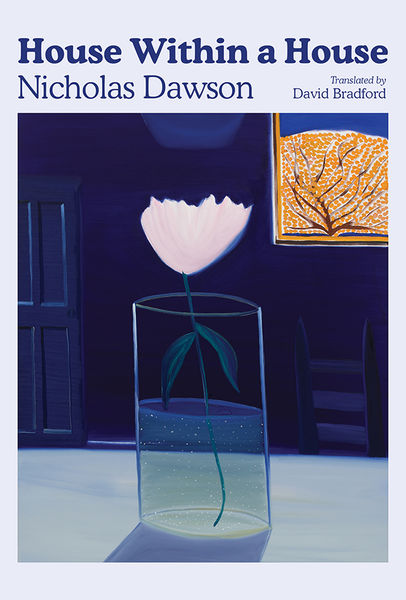D.M. Bradford on Translating Nicholas Dawson's Stunning Poetry Collection, House Within a House
Nicholas Dawson's Désormais, ma demeure (Triptyque, 2020) was received as a powerful and authentic exploration of depression when it was published, and it became one of the most decorated French-language poetry collections of recent years, winning Dawson the Grand Prix du livre de Montréal and the Blue Metropolis Diversity Prize.
A thoughtful exploration of how depression, isolation, and mental health are filtered through a lens of race, queerness, and diaspora, Désormais, ma demeure was hailed as a vulnerable triumph of both emotional intelligence and successful genre blending, with the incorporation of photos, prose poetry, essays, and lyric poetry.
Now English readers have the chance to experience Dawson's brilliant work, courtesy of D.M. Bradford, who translated the collection into English as House Within a House (Brick Books). Bradford, themself a decorated poet whose stunning debut, Dream of No One but Myself, was nominated for the 2022 Griffin Poetry Prize, brings a depth of insight to the translation that creates a vibrant, astonishing collaboration between two of Canada's most exciting poetic minds.
Bradford joins us today to talk about the translation process and how they approached Dawson's stunning original French pieces. House Within a House is Bradford's first full length translation, following years of translation work in other mediums.
He tells us about how Dawson's style in the book ("one-part frenzied, one part meditative") immediately pulled him in, how they saw themself in Dawson's thoughtful exploration of the relationships between depression and race, gender, and queerness, and how the nitty-gritty of translation works for them, including the "power" and "accountability" that come with the role.
Open Book:
What drew you, personally, to this project?
D.M. Bradford:
I found myself falling into the voice of Désormais, ma demeure, the original text for this translation, right away—this impulse to game out how it might read in English was rolling with me as I read. There’s something about Nicholas’s run-on style in this book: the one-part frenzied, one part meditative rhythms with which he layers the contexts that intersect the different times and spaces bound up in his experience of depression. Between that motion and thought, I really saw myself in the way he thinks through depression’s link to diaspora, race, family history, work, gender, queerness, etc. It’s a book I felt in conversation with, a text I wanted to build a deeper relationship with, and translation was the ideal opportunity for that to happen, both on the page and with Nicholas.
OB:
House Within a House incorporates different genres (essay, photography) as well as poems – how did that mixture influence your experience of this translation?
DMB:
Coming to this Nicholas’s work shortly after finishing the last bit of editing work Dream of No One but Myself, my first, also-very-much-hybrid book, it all really made sense to me as a way to contain the story of an uncontainable story, one fragmented in time and space, one that begins in diaspora and carries on after the book ends. So, very quickly I could see how that mix of modes enabled Nicholas and readers to encounter his depression from different vantage points, from different positionalities and times, and with a different set of tools appropriate to each encounter. And really, as a translator, it was a kind of load off. Those photos from Nicholas’s wanderings around the house, those stylistic choices tensioning the different forms in this book, the care and sense with which they were organized to teach a reader how they bounce off each other, how to enjoy that bounce—I didn’t need to translate those, just give them the same room the original work did. Which was kind of a recurring theme for this work: this book knows itself, and it was a pleasure to learn to trust it every step of the way.
OB:
What do you need when you're working– in terms of space, food, rituals, writing instruments?
Your CanLit News
Subscribe to Open Book’s newsletter to get local book events, literary content, writing tips, and more in your inbox
DMB:
I’ve been lucky to have a home office, with a door and everything, for a number of years, so I’d be sad to go without that at this point. Otherwise, I’m relatively easy; though my office setup has gotten nice, it doesn’t feel necessary and I can kind of just sit down and do the thing when it comes to translation as long as it’s kind of quiet. And I draft directly on my computer. Early morning or late night is also key.
A thing that’s probably much more translation specific: coming from a lot of experience translating in corporate and business contexts, for this first book-length translation, I worked from a .pdf out of habit, lining up the translation doc and the original side by side on a biggish screen (I got a monitor about mid-way through the project, which really helped my neck and shoulders, and cut down on all that annoying command+tab time flipping between the documents). Really boring stuff, but it’s a perfectly good way to work, and likely the way I will always proceed past a first transaltion draft, where having the original available at a glance is pretty much always key.
But more recently I’ve had to begin a number of translations working from a physical copy, and I’ve begun to really appreciate the slowness and care that goes into proceeding that way—book pried open in my left hand, right hand typing away. Working this way, the original is not available at a glance, comparatively, and so it inevitably slows me down, forces me to take a more intent look at the nuance and construction of every sentence and passage I’m translating, and I like what that does to the first draft process, both in terms of experience and results.
OB:
What impression or mood are you trying to create for the reader in your translation of this work? What feelings or impressions did the poems evoke for you?
DMB:
Whether it’s the poems dispatched from indoors, right in the thick of Nicholas’s depression, or the memoirish accounts of his times our the house, or the lyrical essays that look back on all of it, that think in more arty ways about how it all never quite leaves a person, that think about it all in a more intertextual way—I really wanted to carry forward this strong impression each piece in the original book left on me that first and foremost what grounds this project is delving into the experience of going through a major depression. The coming to terms with that reality, the motion of seeking help, the motions of a kind of self-imposed confinement, the creativity that sprouts out of it, the lingering effects that pull you back into it from time to time. It’s not a book caught up in gaming out solutions, or defining the condition itself; it’s a much more embodied exploration than that, which is very much what I wanted to reproduce for English-language readers.
OB:
How do you view the role of a translator when it comes to translating creative and literary work?
DMB:
Translating creative work for publication is a lot of power. When you translate such a work, on some level you reify the significance of that work and that writer, you reify your interpretation of aspects of it, and you make it possible for a whole new audience to gain access to your take on that writer’s work. Translators, in my experience, can play a big role in deciding whose work and career gets that boost, and they definitely play a huge role in how that work is received on the page. In the Canadian context, publishers tend to develop relationships with specific translators, and often that entails trusting each of their translators’ nose for works to select for translation, trusting them to be honest about whether or not they’re the right fit to translate said works, trusting them to do without an editor that can really assess the work that was done by reading the source text, etc.
So, a large part of the role for me is accountability: for the selections I make, for my ability to carry that work through. That means being careful what translation projects I choose to push, and being ethical and generous in my approach to each project I get to pursue. For me, the selection part entails making space for odd and/or hybrid and/or arty work by writers from marginalized communities. The Canadian publishing landscape is still very much dominated by mainstream white cishet voices and I think this is even truer with translation, both in terms of translators doing the work and the writers being translated.
With that at least in the back of my mind, and as a gender nonconforming writer of colour doing sometimes unusual work myself, I think my role with my translation practice is to push to translate work that’s close to my heart and for which I’m the right fit, work that’s different than what other kinds of editors and translators have tended to select for translation in this industry, work which frankly hasn’t received its fair share of that aforementioned reification. Then, it’s on me to pursue ferrying that work over to English readers as conscientiously as I can: with work and work and work, with an open dialogue with the writer (if they’re up for it) and editor, with a loyalty, first and foremost, to the writer’s original work, and with a certain gratitude and love for the opportunity to help rep their work once it’s out in the world.
OB:
Do you find it helpful, when possible, to connect with or speak to the author of the work you’re translating (if they’re available and living), or do you prefer to work in solitude?
DMB:
Always! I’m very much the translator when I work through the writing, but it’s a very different thing if you don’t at least give the writer the opportunity to connect throughout the process. Nicholas and I had many talks, looked over a couple of drafts, and I feel that much better about House Within a House as a result. If a writer isn’t interested, I’m happy to pursue a translation without that interaction. But if they’re open to a dialogue on any level, I’m there.
OB:
What are you working on next?
DMB:
I’m working on figuring out touring my next book, Bottom Rail on Top, this fall! It’s been a long while in the making, and brings together a lot of my riffling through the archives thinking alongside a lot of Black thinkers and a lot dominant historical narratives of Blackness, the ways we as Black folks mediate those in the present, etc. I can’t wait to share the work, but it’s been some x’s and o’s lining up what will likely be a very busy fall on the road.
Otherwise, after a packed spring, I’m working on getting my writing brain back into my next book project—a slippery, weird little prose-y hybrid—and hopefully working slowly and quietly on that over the summer.
_____________________________________________
Darby Minott Bradford is a poet and translator based in Tio’tia:ke (Montreal). Bradford's debut collection, Dream of No One but Myself (Brick Books, 2021), won the A.M. Klein Prize, was longlisted for the Grand Prix du livre de Montréal, and was a finalist for the Griffin Poetry Prize, Governor General’s Literary Award, and Gerard Lampert Memorial Award. His work has also appeared in Brick, The Fiddlehead, fillingStation, The Capilano Review, and elsewhere. House Within a House is his first translation, and Bottom Rail on Top, his second book of poetry, is forthcoming in fall 2023.
Born in Chile and based in Montréal, Nicholas Dawson is a writer, scholar, and the Literary Director of Éditions Triptyque. He is the author of La déposition des chemins (La Peuplade, 2010), Animitas (La Mèche, 2017), and Désormais, ma demeure (Triptyque, 2020), for which he received the Grand Prix du livre de Montréal and the Blue Metropolis Diversity Prize. He is also the co-author of Nous sommes un continent: Correspondance mestiza (Triptyque, 2021, with Karine Rosso), and the editor of many anthologies.
![Black and red banner image with text reading "On translation an interview with D.M. Bradford" and "This book knows itself... [I] trusted it every step of the way". Photo of D.M. Bradford on the right side, Open Book logo on the left side Black and red banner image with text reading "On translation an interview with D.M. Bradford" and "This book knows itself... [I] trusted it every step of the way". Photo of D.M. Bradford on the right side, Open Book logo on the left side](/var/site/storage/images/media/images/open_book_dm_bradford_banner/116531-1-eng-CA/open_book_dm_bradford_banner.jpg)







